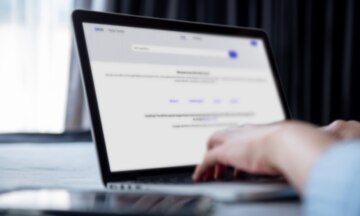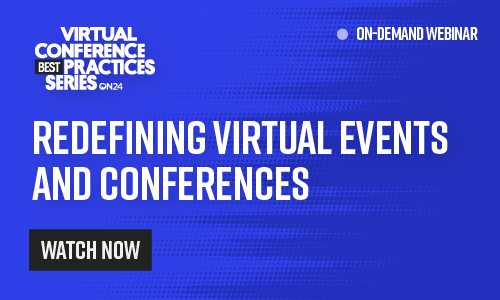Conferences, trade shows and seminars are all excellent ways to generate leads and build important face-to-face relationships. But field events always have limitations marketers need to consider. First, and most crucial, is that not all relevant audiences are going to be able to attend the physical event in question. Budgets, travel restrictions and proximity to a venue all affect attendance.
That’s why every field event — no matter how large or small — should incorporate digital experiences into its strategy. Don’t have a digital angle ready for your in-person event? Don’t worry: combining virtual events and physical, in-person events isn’t hard — all it takes is a little scrappy marketing. Here’s how you can get started:
What Is a Virtual Event?

Before we begin, let’s get some terminology out of the way. A virtual event is an online activity where attendees can interact with a brand through digital channels. Virtual events can be as short as a 20-minute webinar or as long as a morning-long summit. Often, they occur in coordination with a physical in-person event or, on occasion, act as a standalone event.
What are the Main Features of a Virtual Event?
There are various ways virtual events can be held, depending on the virtual event platform used, but each event shares a few common traits. All virtual events are:
Digital — By nature, virtual events take place online in a digital environment.
Interactive — All virtual events should allow attendees to download resources, interact with speakers, and engage with their environment.
Multimedia — Virtual events excel when presenters and sessions contain multimedia elements, like video, GIFs, slides, music, and more.
What is the Difference Between a Digital Experience and a Virtual Event?
Virtual events and digital event experiences are similar ideas at first glance. In fact, a digital event experience has all of the trappings of a virtual event. But on closer examination, the difference between the two is stark.
Digital event experiences, for example, are far more immersive, coordinated and enjoyable from an end-user perspective. They’re more polished and consistent in their presentation than virtual events and tend to draw larger numbers of attendees.
Virtual experiences, by comparison, are short and immediate. One way to think of it is the difference between a massive, multi-day conference and a roadshow across the country. Both have their purposes, but one generates far more buzz.
Develop A Digital Team

Whether you’re moving your in-person event fully online or complimenting your physical presence, having a structured plan in place makes all the difference. The first step is to identify your key stakeholders in your marketing and sales departments. Here’s a list of the marketing roles that ought to be involved:
Program Director – Organizes and develops digital/physical event strategy and approach
Event Coordinator – Identifies event topics and related focus areas
Webinar Manager – Organizes webinar strategy, content creation and promotion
Operations/Demand Gen – Sets up a webinar, webinar production, lead qualification and tracking
For Sales and Customer success, the list is:
Field Reps – For identifying target audiences, personas, accounts and event presence
SDRs – For webinar and event engagement, outreach, promotion and follow up
Customer Success – For event follow-up, trial organization and support
Once assembled, identify how you want to run your digital event experience. Typically, there are three options to consider to incorporate into this digital experience:
-
- In tandem with your in-person event
- As an extension of your physical event
- Or as a post-event experience attendees can enjoy
Also, take this time to identify the target accounts, audiences and personas you want to connect with.
Organize Content and Branding

Content
With planning elements in place, it’s time to organize your content and branding. Content should generally reflect the speaker’s presentation and any handout material you may have onsite. Gather digital copies of relevant e-books, case studies, reports, presentation slides and track down any appropriate virtual-based content as well, like on-demand webinars or blog posts.
Now, it’s time to organize content for your digital event experiences. In general, there are three options to consider when delivering content through a digital experience. Here’s a quick rundown:
Targeted landing pages. Targeted landing pages provide attendees with a quick, concise overview of your presence at an event, along with any relevant handouts or materials. You can also use these pages to stream a webinar or a recording of the in-person event, as well as putting attendees directly in touch with presenters and SDRs via engagement tools like CTAs and virtual business cards.
Content hubs. If you’re running a larger event, like your own conference, or have multiple sessions to share, use a content hub like ON24’s content hub capability. With a content hub in place, you can sign virtual attendees up for multiple presentations throughout an event, provide in-person attendees with presentations they may have missed and — if you’re hosting — organize your breakout sessions and keynotes into tracks or topics.
Live or simulive webinars. Finally, there are webinars, which can stand on their own, or be embedded in the previous two options. Webinars have the option to be streamed live, simulive or on-demand, but for conferences, focusing on live and simulive is best.
You have two options for streaming live webinars: high-quality broadcast streams or webcams. All you need to get started is a webcam and, depending on your set up, a tripod stand. We recommend streaming live webinar presentations through webcams first, as they’re more affordable, scalable and less complex than broadcast video. Broadcast video is best suited when your organization is the conference host and you want to stream keynotes.
More often than not, simulive, where a presenter records their session ahead of time for virtual audiences, is the safest and most practical decision. Sit down with your speaker(s), identify opportunities to engage a virtual audience via polls and Q&A engagement tools and record the presentation. Then, when you broadcast, have a representative available to answer any questions your virtual attendees may have.
Bring your physical events into the digital world. Learn how in this on-demand webinar. [Watch Now]
Regardless of whichever tactic you choose, make sure you build in engagement features for your virtual attendees. These can include simple CTAs, chat rooms and Q&A tools to powerful tactics like interactive pushing polls and surveys during a presentation.
Branding

When it comes to branding, one rule is important: consistency. Landing pages, webinars, content and content hubs all need to match your organization’s theme or design for an in-person event. This also includes physical assets, like booth design and handouts.
Sit down with your designer, design team or agency and list out all of the assets you’ll need to be branded for field events. Once those assets are identified, get your design in order and make templates out of them. This way, attendees — both in-person and virtual — have a consistent experience no matter where they engage your brand. You can (and ought to!) reuse these templates with other events as well.
Run Your Event and Move to On-Demand

Okay, so you have a plan in place, content ready, consistent branding and folks registering. All that’s left is to run your digital event experience. Right?
First, there are a few things to keep in mind to make your events go as smoothly as possible. These items include setting up email reminders (before, during and after your in-person event starts), practicing live presentations ahead of time to run through any technical issues, recording and organizing your simulive events in content hubs and landing pages and training your team on how to engage virtual attendees. But these steps should be relatively easy to work through.
With an organized approach, your event should run smoothly. Remember to take the time to engage your virtual audience, acknowledge their presence, answer questions and push your in-person attendees to your digital event experience for additional resources. When the event is over, make sure your digital experiences reflect that fact. Update your content hubs and landing pages to say the conference, trade show or field event is over. You don’t want any confusion over the status of an event.
The On-Demand Element

Unlike in-person trade shows and conferences, digital event experiences don’t have an expiration date. To take full advantage of digital experiences and to extend the impact of your in-person event, have a plan in place for on-demand access.
For on-demand, you have a few options. The easiest is to simply push recordings of your event into on-demand content hubs for consumption. But if you want to go the extra mile, develop a few ideas that can extend your in-person assets — speakers, subject-matter experts and attendees — and expand on your event’s impact.
Here are some easy to do examples that you can do live or on-demand:
Coffee Talk
An informal, unscripted chat between two to three people for about a half-hour. The best format for a Coffee Talk is video — all you need to do is grab a webcam or camcorder and start recording. If you want to add some production to it, get an HD camera, record the discussion and push the recording on-demand. If you’re in a pinch, an audio recording can also suffice.
Fireside Chat
A bit more involved than the Coffee Talk, a Fireside Chat is typically a high-quality video recording of a casual but structured conversation between a moderator and a few guests for about an hour. Since fireside chats usually involve keynote or high-quality speakers consider putting some extra focus on the quality of the recording.
Subject Matter Expert Keynote
Audiences love reports, charts and statistics. So, a traditional presentation where a speaker presents new research, industry trends, their experiences or other related topics to the audience is a great opportunity for on-demand engagement. For this, talk to customers, internal experts and industry subject-matter experts and get permission to both record presentations in either audio or video formats and share the presentation’s slides.
Extra Q&A Sessions
Extra Q&A sessions are low-effort, high-impact opportunities to add value to both in-person and virtual attendees. Grab a webcam, set up a small space and take five to fifteen minutes with a subject matter expert to run through additional Q&A submissions. It’s a great opportunity for them to answer key questions that official sessions might not have had time to cover during their presentations.
And that’s it, really. If you’re crunched for time, go through and identify the actions that are easy to produce but have a high impact for your audiences. This is sure to elevate the quality of your digital event experience.


